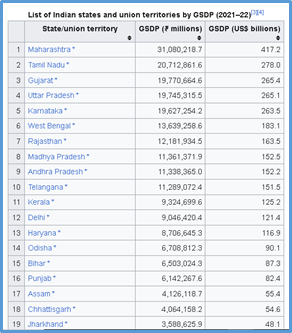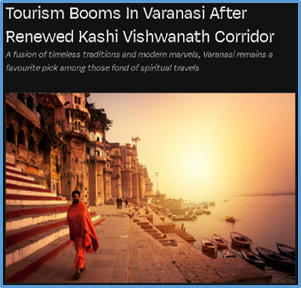"Analyzing Bloomberg's Take on India and Modi: A Closer Look"
- peacetalks24
- Apr 22, 2024
- 11 min read
An opinion piece titled "India's South Rejects Modi — And Why It Matters.", which carries significant divisiveness and inherent ignorance, was recently published by Bloomberg Media. The article, written by Andy Mukherjee, sets off by contrasting the states of North and South India, criticizing the former and applauding the latter for what is purported to be its superiority.
As per him, the states that support Prime Minister Narendra Modi, including as Uttar Pradesh and Bihar, are impoverished and underdeveloped, whereas states in the South thrive because they oppose Modi's leadership. Mukherjee also takes issue with how the current government has handled Hindutva and the building of the Ram Mandir.
He also drew attention to the situation of Delhi Chief Minister Arvind Kejriwal, highlighting his detention and the political hold of CPI-M, DMK and Congress in the states: Kerala, Tamilnadu and Karnataka respectively. The article attempts to instill a divisive idea and sow strife between North and South India while looking down on North India.
The columnist used data from five states Uttar Pradesh, Bihar, Jharkhand, Chhattisgarh and Rajasthan collectively as North Indian states in contrast with Tamilnadu, Kerala, Karnataka, Andhra Pradesh and Telangana as South Indian states. At instances he also used data points of Madhya Pradesh and Gujarat individually.
The columnist of the said article, Andy Mukherjee projects philosophies like Periyarism and Marxism, in a benign light.
Mukherjee goes so far as to say that individuals in North India who support the Bharatiya Janata Party are portrayed as poor, illiterate, and uncivilized, whilst those in the South who oppose Modi are shown as cognitively superior and succeeding in many human development indicators.Each statement from the article is disputable and can be countered with facts, figures, and proper analysis.
Here are major declarations made by the Author Andy Mukherjee, followed by a categorical retort to them all one by one:
Assertion 1: Uttar Pradesh is poorer than Sub-Saharan Africa
The article's comparison of Uttar Pradesh to Sub-Saharan Africa calls into doubt the author's comprehension of both regions' economic realities.
As a native of North India, the author is likely familiar with places such as Noida, Lucknow, Varanasi, and Prayagraj, each with its own level of development and infrastructure.
While UP suffers its own set of developmental issues, such as poverty and infrastructure shortages, comparing its economic situation to that of cities in Sub-Saharan Africa may ignore significant differences.
Under the direction of the current Chief Minister, the state administration wants to increase UP’s state Gross Domestic Product (SGDP) from $313 billion to a trillion dollar economy.
Uttar Pradesh's economic prominence is more noticeable when compared to the GDP figures of numerous sub-Saharan African nations, including Angola, Botswana, Kenya, and Liberia.
The GDPs of Angola, Botswana, Kenya, and Liberia (PPP) are $135.558 billion, $61 billion, $113.42 billion, and $8 billion, respectively. Nigeria's $477 billion GDP makes it stand out among African nations.
Although it is evident that UP has faced developmental impediments under past political governments, drawing comparisons between the state's economic situation and that of sub-Saharan African nations may oversimplify the complex issues involved.
It is crucial to recognize the strides being made in Uttar Pradesh's economic development and growth, as well as the ongoing obstacles and the measures the present administration is doing to overcome them.
Even while comparing the per capita GDP of the states and overall state GDP a different story emerges which thrashes the false narrative of Bloomberg’s article.
In overall state GDP Tamilnadu and Gujarat stands next to each other. Gujarat ruled by Narendra Modi himself as the CM for 12 years.
Now the argument that economic development under PM Modi is not possible therefore Southern states don’t elect him, doesn’t hold water here.
More complexities and issues are involved when it comes to parliamentary politics in a democracy like India, which can’t be ruled out while assessing such topics. The oversimplification made the arguments in the articles flawed to its core
Assertion 2: The current government’s handling of the Ram Mandir construction was unnecessary
Historical evidence suggest that Mughal Emperor Babur’s commander Mir Baqi destructed Ram Temple at Ayodhya and erected a mosque back in 1528-29 CE. The temple site was believed to be the birthplace of lord Ram thus called as Ram Janmbhoomi. The presence of a temple at the site, below the mosque was substantiated through ASI’s (Archeological survey of India) survey.
In November, 2019, the Supreme Court gave verdict in the Ram Janmbhoomi title suit and it was handed over to a trust to be formed by the government. Following the given ruling of the apex court, the government formed a trust to oversee the temple construction which is going to be consecrated on January 22, 2024.
Furthermore, the article presents arguments that what a temple would do.
Ever since the foundation of a temple is laid, hundreds of people get their livelihood till the construction is complete. After the temple is constructed, several persons’ livelihood such as those of priests, security guard, flower vendors, servants doing cleaning and maintenance work in temple, guards, staff in the offices of temples etc. depend on the day-to-day activities in the temple.
There are several things such as auxiliary businesses associated with the temple. The production and business in all these things keep thousands of traders and Stores busy. A temple is backbone of all these economic activities. If a temple is there, there would be worship. Now consider the people involved with activities of various worships -the priest, the musicians, the singers, the garland maker etc. — these also can be added to the list of beneficiaries. If a temple disappears, all these economic activities also would disappear.
A boom in spiritual/religious/temple/pilgrimage tourism is gathering strength in India. The Union tourism ministry data shows over 60% of tourism in India is in the religious and spiritual tourism category. Ministry data also suggests that economies surrounding places of worship in India raked in close to Rs 1.3 lakh crore in 2022, doubling up from Rs 65,070 crore in 2021.
After the renovation of Kashi Vishwanath Corridor, Varanasi has experienced it well. Hospitality industry is flocking to Ayodhya now, as the religious tourism in India witnesses accelerated growth and the upcoming Ram Temple is adding another attraction to the historical site.
Ayodhya, which hosted the historic Ram Temple inauguration on January 22, 2024 undergoing a major shift which sends waves all across. The churning of historical facts and political ambitions manifested into a Temple which is standing tall to cater to an ocean of faith. Ram Temple in Ayodhya as been opened for the devotees and whole of India celebrated the occasion with great fervor.
Uttar Pradesh will get a major boost in its state GDP and the target of achieving $1 trillion might be achieved having Ayodhya as the growth engine of it. The Temple will boost the economy through the in-bound tourism therefore the arrangements are being made to bridge the linguistic differences through employment of linguists. This will promote cultural unity amongst Indians as one.
It is essential to understand that temple runs the engine of economy with the devotion being the fuel of it. UP will grab this huge opportunity provided with the Ayodhya Temple opening to achieve the mark on economic front which it aspired. Therefore, it can be said that temple is necessary for economic growth and that makes government’s role much important.
h


















Comentarios